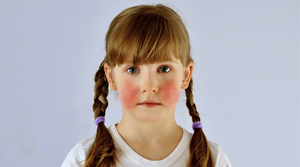Are you concerned about the skin problems your child is facing? You are not alone. Many parents struggle to find effective ways to treat and prevent skin issues in their children. From eczema and acne to warts and ringworm, children can experience a variety of skin problems that can be both uncomfortable and unsightly.
In this blog, we will explore the most common skin problems in children, their causes, and the various treatment options available. We will also discuss how to prevent skin problems in children. We will provide information that will help you understand your child's skin condition.
Whether you are a parent of a child with a persistent skin condition or just want to learn more about common skin problems in children, this guide is for you.
Common Skin Problems in Children
Eczema
Eczema, also known as atopic dermatitis, is a chronic skin condition that causes dry, itchy, and irritated skin. The most common symptoms of eczema are red, inflamed, and itchy skin, as well as dry, scaly, or rough patches. The exact cause of eczema is unknown, but it is believed to be a combination of genetic and environmental factors.
Acne
Acne is a common skin condition that affects both children and adults. It is characterized by the appearance of pimples, blackheads, and whiteheads on the face, chest, and back. The main causes of acne are hormonal changes, overproduction of oil, and the presence of bacteria on the skin.
Impetigo
Impetigo is a contagious skin infection caused by bacteria. It is characterized by the appearance of red sores that can turn into crusty blisters. The sores are usually found on the face, particularly around the nose and mouth. Impetigo is usually caused by staphylococcus or streptococcus bacteria and can be spread through close contact or by sharing personal items.
Ringworm
Ringworm is a fungal infection that affects the skin, scalp, and nails. It is characterized by the appearance of a ring-shaped rash that is red, scaly, and itchy. Ringworm can be caused by a variety of fungal species and is highly contagious.
Warts
Warts are small, benign tumors that can appear on any part of the body. They are caused by the human papillomavirus (HPV) and are contagious. Warts can be flesh-colored, white, or brown, and have a rough surface. They are most commonly found on the hands and feet.
Pityriasis Rosea
Pityriasis rosea is a skin condition that is characterized by the appearance of a large, scaly, pink rash on the chest and back. The rash is usually accompanied by smaller, similar rashes on other parts of the body. The cause of pityriasis rosea is unknown, but it is thought to be related to a viral infection.
Causes of Skin Problems in Children
Genetics
Many skin conditions, such as eczema, are believed to have a genetic component. If a parent or close relative has a skin condition, a child is more likely to develop it as well.
Allergies
Allergies can also play a role in the development of skin problems in children. Children with allergies are more likely to develop eczema, and certain allergens such as food, pollen, or animal dander can trigger symptoms.
Hormonal changes
Hormonal changes can also contribute to the development of skin problems in children. For example, acne is often caused by an increase in hormones called androgens, which can cause the sebaceous glands to produce more oil.
Environmental factors
Environmental factors such as pollution, weather, and exposure to irritants can also contribute to skin problems in children. For example, exposure to harsh soaps and detergents can dry out the skin, making it more susceptible to eczema.
Prevention and Remedies
Tips for preventing skin problems in children
- Keep the skin clean and moisturized
- Avoid harsh soaps and detergents
- Use mild, fragrance-free products
- Avoid excessive exposure to the sun
- Keep the skin cool and dry
- Avoid scratching and rubbing irritated skin
- Avoid triggers such as certain foods, stress, and certain fabrics.
Home remedies for treating common skin issues
- Use coconut oil or olive oil as a moisturizer
- Apply aloe vera gel to soothe irritated skin
- Use a mixture of baking soda and water to exfoliate the skin
- Apply a mixture of honey and turmeric to the affected area to reduce inflammation
- Use a cool compress to reduce itching and inflammation
Over-the-counter and prescription treatments
- Cleansers: there are many over-the-counter cleansers available that are formulated to treat specific skin conditions such as acne, eczema, and impetigo.
- Moisturizers: Moisturizers can help to soothe irritated skin and provide hydration. They can be over-the-counter or prescription.
- Topical creams and ointments: Over-the-counter creams and ointments are available to treat specific skin conditions such as eczema and impetigo.
- Oral medications: For more severe cases, oral medications such as antibiotics or antihistamines may be prescribed.
Your Child's Health is in Your Hands
It is important for parents to be aware of the potential causes of skin problems in children and to take steps to prevent them. If a child does develop a skin condition, it is important to seek medical help to determine the best course of treatment.
Parents should also be mindful of their child's environment and lifestyle habits, and to consult with a pediatrician or a dermatologist if they suspect that their child's skin condition is caused by one of these factors.
With the right knowledge and treatment, parents can help their children to alleviate the symptoms and to achieve healthy, clear skin.

